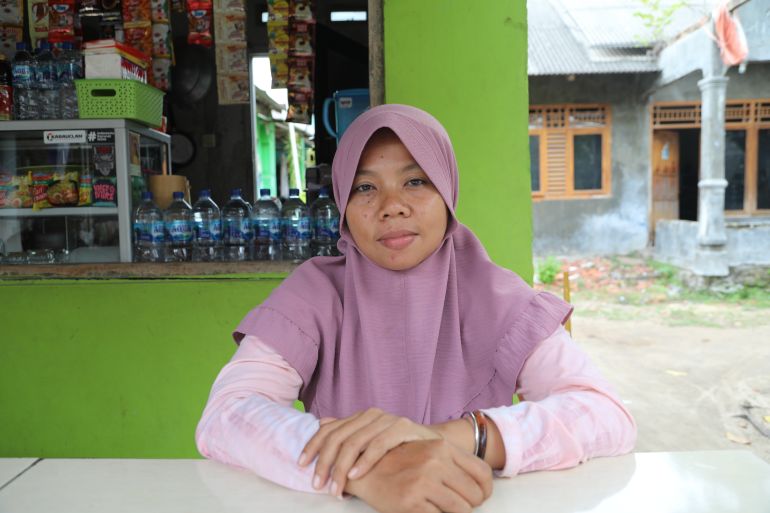Four Indonesians take Swiss cement giant to court over climate
The plaintiffs want damages that reflect Holcim’s contribution to the climate change that has made island life increasingly difficult.

When the first tidal wave struck Pari Island back in 2018, Arif Pujianto’s entire home was flooded for more than 24 hours, contaminating the well from where he sourced his drinking water, rusting his motorbike and leading timber panels to fall off the walls.
The 51-year-old fisherman was forced to abandon his belongings and flee with his wife and son to the other side of the Indonesian island, part of the famed Thousand Islands that lie off Java’s northwestern coast, staying with a friend overnight.
“I was afraid,” Pujianto told Al Jazeera. “I became a refugee on my own land.”
The low-lying island of Pari, about 40km (25 miles) north of Jakarta, is on the front lines of the world’s climate crisis. Extreme flooding is killing off trees and driving away tourists; chaotic weather has devastated fishing hauls; and rising sea levels are submerging the island of 1,500 residents.
On average, Pari lies about 1.5 metres (4.9 feet) above sea level.
“I am angry with the situation,” says Pujianto, who now uses rainwater to desalinate his well. “I want to protect my land. I think about the future of my son, my family.”
On Wednesday, Pujianto and three other plaintiffs on Pari announced that they had formally lodged a lawsuit against the Swiss-based cement producer Holcim for its alleged role in the climate crisis. In July 2022, they submitted a request for conciliation in Zug, Switzerland – where Holcim has its headquarters – but with no agreement reached, they have decided to sue the company in the Swiss civil court.
An aerial view of Pari island. It's a slither of land surrounded by clear waters and the Java Sea. There is a settlement on the right hand side of the island and lots of trees elsewhere. The island tapers to the top and bottom
Supported by the Indonesian Forum for the Environment (WALHI), Swiss Church Aid (HEKS) and the European Center for Constitutional and Human Rights, the plaintiffs are demanding that Holcim, the world’s largest manufacturer of building materials, reduce its carbon dioxide emissions by 43 percent by 2030.
They are also demanding the company co-finance adaptation measures on Pari such as mangrove plantations and, significantly, that it pays “loss and damage” for its role in the climate crisis.
According to a HEKS-commissioned study by the Climate Accountability Institute in the United States, Holcim emitted more than 7 billion tonnes of carbon dioxide between 1950 and 2021 – the equivalent of 0.42 percent of all global industrial emissions in human history.
The Pari claimants are seeking a total of 14,700 Swiss francs ($16,000), about $4,000 each, which has been calculated as proportional to Holcim’s contribution to overall climate damage.
“Holcim has been aware of the high emissions created by cement production and its impacts on the climate for at least 30 years,” says Lorenz Kummer, a campaigner at HEKS. “Nonetheless, over that time, the company more than doubled its emissions and those damaging effects are being felt by the people of Pari.”
A spokesperson for Holcim said in a statement that climate action was a “top priority” for the company and that it was “taking individual action and supporting global multilateral frameworks for collective impact to be part of the solution.”
The statement added: “We do not believe that court cases focused on single companies are an effective mechanism to tackle the global complexity of climate action.”
The Pari islanders’ case against Holcim, one of the first to be initiated by affected parties from the Global South, is part of a growing movement for “loss and damage” and could be the catalyst for more climate litigation.
The case marks the first time a Swiss company is being held accountable in the courts for its role in climate change.
“This kind of litigation shows that policymakers aren’t doing enough to address the needs of the people impacted,” says Noah Walker-Crawford, a researcher specialising in climate litigation at University College London.
“If the claimants were to win, it would set a massive precedent. It would make those responsible for the damage pay.”
‘Global justice’
Campaigners argue it is a matter of “global justice” that people living mostly in developing countries receive compensation as they have been disproportionately affected by climate-related damages and losses – through flooding, heat waves, storms, droughts and more – largely caused by industrialised countries and global corporations.
According to an analysis in July, the US has since 1990 inflicted more than $1.9 trillion in damages to other, mostly poor, countries as a result of its greenhouse gas emissions – through heatwaves, crop failures and other consequences.
At the United Nations Climate Change Conference (COP27) in November, European leaders acknowledged their role in the climate crisis and agreed to set up a “loss and damage” fund to help the most vulnerable but no concrete investment has yet been established, nor a mechanism by which the funds can be dispersed.
-al jazeera






